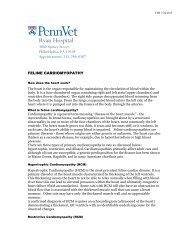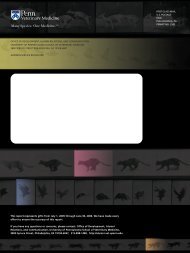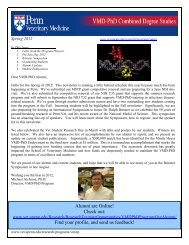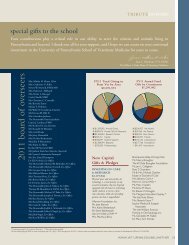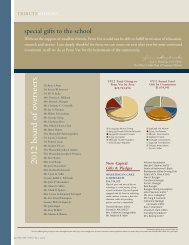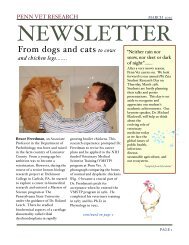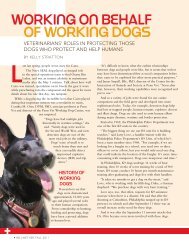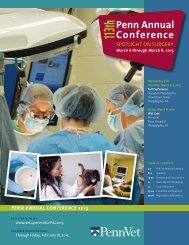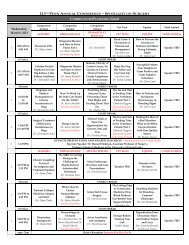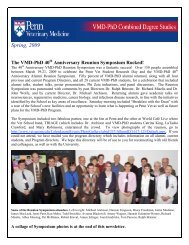Dec JAN Newsletter 2009-2010 - University of Pennsylvania School ...
Dec JAN Newsletter 2009-2010 - University of Pennsylvania School ...
Dec JAN Newsletter 2009-2010 - University of Pennsylvania School ...
Create successful ePaper yourself
Turn your PDF publications into a flip-book with our unique Google optimized e-Paper software.
PENN VET RESEARCH DECEMBER <strong>2009</strong><br />
continued from page 1<br />
can be curative in some cases, cats<br />
rarely show symptoms until the<br />
cancer has advanced to an inoperable<br />
size. In addition, oral SCC has<br />
historically been minimally responsive<br />
to radiation therapy and current<br />
chemotherapy options. Based on his<br />
interest in SCC, Dr. Lewis jumped at<br />
the chance to join a residency<br />
program at Penn Vet to further<br />
explore surgical and non-surgical<br />
options for improving the outcome<br />
for SCC patients.<br />
Treatment <strong>of</strong> oral SSC in feline<br />
patients- room for improvement<br />
SCC is the most common feline oral<br />
tumor, representing 70% <strong>of</strong> feline<br />
oral tumors. 1 As the median survival<br />
time from diagnosis to death or<br />
euthanasia is approximately 60 days 2 ,<br />
there is much room for improvement.<br />
While Dr. Lewis was eager to<br />
hone his surgical skills for treatment<br />
<strong>of</strong> feline SCC patients from<br />
established experts like Colin Harvey<br />
and Alexander Reiter at Penn Vet, he<br />
also saw an opportunity to improve<br />
treatment options for patients who<br />
were not surgical candidates. In<br />
conjunction with Dr. Tom O’Brien’s<br />
group at Lankenau Institute for<br />
Medical Research, Dr. Lewis and<br />
colleagues in Penn Vet’s Oncology<br />
Section and Dentistry and Oral<br />
Surgery Service embarked on a Phase<br />
I/II clinical trial <strong>of</strong> polyamine<br />
inhibitor therapy for cats with<br />
spontaneously occurring oral SSC.<br />
Dr. O’Brien, renowned for his work<br />
on the role <strong>of</strong> polyamines in cancer<br />
cell growth and successful polyaminebased<br />
therapy in experimentally<br />
induced murine models <strong>of</strong> SCC 3 , was<br />
anxious to evaluate this therapy in a<br />
spontaneous feline model, so the<br />
collaboration was initiated.<br />
Polyamine inhibitors<br />
Polyamines are ubiquitous amino acid<br />
derived compounds that have been<br />
widely implicated in the growth and<br />
development <strong>of</strong> many mammalian<br />
tissues. When cellular polyamine<br />
synthesis is inhibited, cell growth is<br />
stopped or severely retarded.<br />
Providing exogenous polyamines<br />
restores the growth <strong>of</strong> cells.<br />
Polyamine synthesis is increased in<br />
many types <strong>of</strong> cancers and expression<br />
levels <strong>of</strong> the rate limiting synthetic<br />
enzyme, ornithine decarboxylase<br />
(ODC), are <strong>of</strong>ten increased as well. 4<br />
As Dr. O’Brien’s original studies<br />
indicated that the ODC inhibitor<br />
difluoromethylornithine (DFMO) was<br />
effective in treating experimentally<br />
induced murine SCC 5 , a Phase I/II<br />
study was carried out to determine<br />
whether cats tolerate DFMO. Results<br />
<strong>of</strong> this study will soon be submitted<br />
for publication, but the relatively<br />
minimal side effects seen with DFMO<br />
protocols suggest that further studies<br />
are justified for use in a clinical<br />
setting.<br />
Although targeting polyamine<br />
synthesis with ODC inhibitors can be<br />
effective for cancer cell growth<br />
inhibition, most eukaryotic cells have<br />
a polyamine transport system in their<br />
cell membrane that facilitates<br />
internalization <strong>of</strong> extracellular<br />
polyamines. Thus, polyamine synthesis<br />
inhibitors will only fight half the<br />
battle in reducing intracellular<br />
polyamine levels. To overcome this<br />
limitation, Dr. Lewis’ latest study<br />
focuses on treating cats affected by<br />
oral SCC with a combination therapy<br />
utilizing DFMO and a polyamine<br />
transport inhibitor developed by MBF<br />
Therapeutics. The Veterinary Clinical<br />
Investigation Center (VCIC) has<br />
greatly facilitated all phases <strong>of</strong> this<br />
second combination study, and Dr.<br />
Lewis further credits the team effort<br />
put forth between Dr. Karin<br />
Sorenmo, Dr. Erika Krick, Dr. Nicola<br />
Mason, members <strong>of</strong> the Dentistry and<br />
Oral Surgery Service, Sections <strong>of</strong><br />
Radiology and Pathology, and practitioners<br />
who have shown interest in<br />
referring cases. While this study is still<br />
ongoing, it is the hope that such<br />
combined therapy will halt cancer<br />
growth but not significantly diminish<br />
other important quality <strong>of</strong> life aspects.<br />
Pets- man’s best friends provide<br />
hope for the future<br />
Feline oral SCC is a frustrating disease<br />
for pet owners, and there is an overt<br />
willingness <strong>of</strong> pet owners to help find<br />
better treatment options. Clients<br />
from near and far have inquired about<br />
ongoing SCC studies for treatment <strong>of</strong><br />
their cats. Indeed, one family from<br />
Chicago, the Dehertoghs, traveled to<br />
Penn for treatment <strong>of</strong> their cat, Tiger.<br />
Within a year, the Dehertoghs’ other<br />
cat, Elsa, developed oral SCC and was<br />
also enrolled in the study. Most<br />
notably, Ms. Kathleen Jack created the<br />
Feline Oral SCC Research Fund to<br />
support Dr. Lewis’ research when her<br />
cat, Bud, was diagnosed with the<br />
disease. While increased research on<br />
feline oral SCC will undoubtedly<br />
benefit feline patients, it is Dr. Lewis’<br />
hope that such research will also have<br />
important implications for human<br />
patients.<br />
Dr. Lewis’ belief that spontaneous<br />
companion animal cancer models<br />
continued on page 5<br />
PAGE 4



